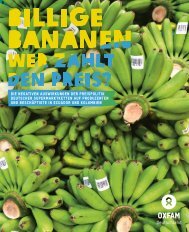228776e
228776e
228776e
You also want an ePaper? Increase the reach of your titles
YUMPU automatically turns print PDFs into web optimized ePapers that Google loves.
Didactic approach<br />
The Albanian curriculum stipulates that ‘practical activities’ should accompany specific<br />
topics. All the textbooks except T3 therefore address the rescue of Jews in Albania by<br />
requesting teachers and/or pupils to seek and provide their own historical documents.<br />
However, this topic is not dealt with in the body of any of the textbooks outlined here, and<br />
no books indicate what documents to select or how to implement them didactically in the<br />
classroom. T5 goes into more detail about such rescues by requesting pupils to formulate<br />
their own opinions about motivations for rescue in moral terms (such as hospitality,<br />
religious tolerance, humanism and antifascism as national attributes, and the propensity of<br />
Albanians to offer protection since they were also dependent upon the protection of others).<br />
T1 and T4 name the didactic exercises at the end of each chapter ‘Control and Systematic<br />
Knowledge’. The exercises generally require pupils to name and correlate dates and events,<br />
explain key terms and respond to multiple choice questions.<br />
National idiosyncrasies<br />
Since the books are largely devoted to the world civilizations among which Albania is not<br />
included, few references are made to this country’s role in the Holocaust. One exception is<br />
the mention of the rescue of Jews by Albanians during the Second World War in the context<br />
of exercises set at the end of chapters. These are presented either as open questions to be<br />
researched by pupils or teachers, or else as a moral (rather than a historical) issue in which<br />
moral virtues are ascribed to the Albanian people as a nation. 50<br />
Bibliography<br />
T1: Filo, L. and Sala, G. 2010. Historia e qytetërimit botëror. (bërthamë). [The History of World Civilizations.<br />
Framework]. Tirana, Botimet Ideart. (history of world civilizations, age 17-18 years, in Albanian)<br />
T2: Kumbulla-Goce, V. 2010. Historia e qytetërimit botëror. (Kurrikula bërthamë). [The History of World Civilizations.<br />
Framework Curriculum]. Tirana, Shtëpia botuese filara. (history, age 16-17 years, in Albanian)<br />
T3: Mezini, A., Gjeçovi, X., Sadikaj, D. and Bajraktari, J. 1997. Historia 3 [history for the Third Class]. Tirana, Shtëpia<br />
botuese e librit shkollor. (history, age 16-17 years, in Albanian)<br />
T4: Dërguti, M. and Treska, T. 2010. Historia e qytetërimit botëror 11 [The History of World Civilizations. 11 Class].<br />
Tirana, Albas. (history of world civilizations, age 16-17 years, in Albanian)<br />
T5: Paolucci, S., Signori, G. and Thëngjilli, P. 2010. Historia e qytetërimit botëror XI {[The History of World<br />
Civilizations. 11 Class], Tirana, Pegi. (history, age 17 years, in Albanian)<br />
50 The textbooks thus reflect the marginalized, if not expedient, use, of the Holocaust in the public sphere in order to<br />
promote national pride and an image of Albania as a European country promoting ethnic and religious tolerance. See<br />
Perez, D. 2013. ‘Our Conscience is Clean’. Albanian Elites and the Memory of the Holocaust in Postsocialist Albania.<br />
J.-P. Himka and J. Beata Michlic (eds), Bringing the Dark Past to Light. The Reception of the Holocaust in Postcommunist<br />
Europe. Lincoln, The University of Nebraska Press, pp. 25-58, 51.<br />
79




